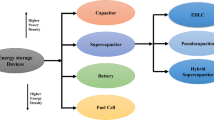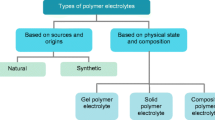Abstract
The wetting time of porous electrodes with electrolytes based on organic solvents and ionic liquids, respectively, was investigated with two different techniques: with a tensiometer and by impedance spectroscopy. The results of this study showed that the wetting time of a porous electrode with ionic liquid-based electrolytes is up to 20 times longer than that with electrolytes comprising organic solvents. A significant reduction in the wetting time with ionic liquid-based electrolytes could be achieved by adding organic solvents. This effect can be explained by the interplay of reduced viscosity, increased surface tension and change in contact angle caused by the addition of the organic solvent, with the lower viscosity being the main driver of improved wetting kinetics.




Similar content being viewed by others
References
van Schalkwijk WA, Scrosati B (2002) Advances in Lithium-Ion Batteries. Kluwer Academic/Plenum Publishers, Dutch
Nazri GA, Pistoia G (2004) Lithium Batteries. Kluwer Academic Publishers, Dutch
Armand M, Endres F, MacFarlane DR, Ohno H, Scrosati B (2009) Ionic-liquid materials for the electrochemical challenges of the future. Nat Mater 8:621–629
Galiński M, Lewandowski A, Stępniak I (2006) Ionic liquids as electrolytes. Electrochim Acta 51:5567–5580
Saint J, Best AS, Hollenkamp AF, Kerr J, Shin JH, Doeff MM (2008) Compatibility of LixTiyMn1−yO2 (y = 0, 0.11) electrode materials with pyrrolidinium-based ionic liquid electrolyte systems. J Electrochem Soc 155:A172–A180
Egashira M, Kanetomo A, Yoshimoto N, Morita M (2011) Charge-discharge rate of spinel lithium manganese oxide and olivine lithium iron phosphate in ionic liquid-based electrolytes. J Power Sources 196:6419–6424
Balducci A, Jeong SS, Kim GT, Passerini S, Winter M, Schmuck M, Appetecchi GB, Marcilla R, Mecerreyes D, Barsukov V, Khomenko V, Cantero I, De Meatza I, Holzapfel M, Tran N (2011) Development of safe, green and high performance ionic liquids-based batteries (ILLIBATT project). J Power Sources 196:9719–9730
Reiter J, Nádherná M, Dominko R (2012) Graphite and LiCo1/3Mn1/3Ni1/3O2 electrodes with piperidinium ionic liquid and lithium bis(fluorosulfonyl)imide for Li-ion batteries. J Power Sources 205:402–407
Xu K (2004) Nonaqueous liquid electrolytes for lithium-based rechargeable batteries. Chem Rev 104:4303–4417
Wu MS, Liao TL, Wang YY, Wan CC (2004) Assessment of the wettability of porous electrodes for lithium-ion batteries. J Appl Electrochem 34:797–805
Stefan CS, Lemordant D, Claude-Montigny B, Violleau D (2009) Are ionic liquids based on pyrrolidinium imide able to wet separators and electrodes used for Li-ion batteries? J Power Sources 189:1174–1178
Dahbi M, Violleau D, Ghamouss F, Jacquemin J, Tran-Van F, Lemordant D, Anouti M (2012) Interfacial properties of LiTFSI and LiPF6-based electrolytes in binary and ternary mixtures of alkylcarbonates on graphite electrodes and Celgard separator. Ind Eng Chem Res 51:5240–5245
Chagnes A, Diaw M, Carré B, Willmann P, Lemordant D (2005) Imidazolium-organic solvent mixtures as electrolytes for lithium batteries. J Power Sources 145:82–88
Choi JA, Shim EG, Scrosati B, Kim DW (2010) Mixed electrolytes of organic solvents and ionic liquid for rechargeable lithium-ion batteries. Bull Korean Chem Soc 31:3190–3194
Xiang HF, Yin B, Wang H, Lin HW, Ge XW, Xie S, Chen CH (2010) Improving electrochemical properties of room temperature ionic liquid (RTIL) based electrolyte for Li-ion batteries. Electrochim Acta 55:5204–5209
Lane GH, Best AS, MacFarlane DR, Forsyth M, Bayley PM, Hollenkamp AF (2010) The electrochemistry of lithium in ionic liquid/organic diluent mixtures. Electrochim Acta 55:8947–8952
Guerfi A, Dontigny M, Charest P, Petitclerc M, Lagacé M, Vijh A, Zaghib K (2010) Improved electrolytes for Li-ion batteries: mixtures of ionic liquid and organic electrolyte with enhanced safety and electrochemical performance. J Power Sources 195:845–852
Kühnel RS, Böckenfeld N, Passerini S, Winter M, Balducci A (2011) Mixtures of ionic liquid and organic carbonate as electrolyte with improved safety and performance for rechargeable lithium batteries. Electrochem Acta 56:4092–4099
Lundblad A, Bergman B (1997) Determination of contact angle in porous molten-carbonate fuel-cell electrodes. J Electrochem Soc 144:984–987
Lucas R (1918) Ueber das Zeitgesetz des kapillaren Aufstiegs von Flüssigkeiten. Kolloid Z 23:15–22
Washburn EW (1921) The dynamics of capillary flow. Phys Rev 17:273–283
Cai J, Yu B (2011) A discussion of the effect of tortuosity on the capillary imbibition in porous media. Transp Porous Med 89:251–263
Fries N, Dreyer M (2008) An analytic solution of capillary rise restrained by gravity. J Colloid Interface Sc 320:259–263
Acknowledgments
The authors wish to thank the University of Muenster, the Ministry of Innovation, Science and Research of North Rhine-Westphalia (MIWF) within the project “Superkondensator und Lithium-Ionen-Hybrid-Superkondensatoren auf der Basis ionischer Flüssigkeiten” and the Federal Ministry of Education and Research (BMBF) within the project “Neue Lithium-Gelpolymerelektrolyte basierend auf neu synthetisierten Homo- und Block-Copolymeren” (project number 03SF0390) for the financial support. Furthermore, we would like to thank Xin Qi for carrying out the Hg porosimetry measurement.
Author information
Authors and Affiliations
Corresponding authors
Rights and permissions
About this article
Cite this article
Kühnel, RS., Obeidi, S., Lübke, M. et al. Evaluation of the wetting time of porous electrodes in electrolytic solutions containing ionic liquid. J Appl Electrochem 43, 697–704 (2013). https://doi.org/10.1007/s10800-013-0558-x
Received:
Accepted:
Published:
Issue Date:
DOI: https://doi.org/10.1007/s10800-013-0558-x




